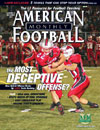AMERICAN FOOTBALL MONTHLY THE #1 RESOURCE FOR FOOTBALL COACHES
Article CategoriesAFM Magazine
|
AFM Subscribers Ask...with Hal Mummeby: Hal MummeHead Football Coach, Southeastern Louisi © More from this issue Changing the fortunes at colleges has been a way of life for New Mexico State’s Hal Mumme. The Texas native has turned around the programs at four colleges – Iowa Wesleyan, Valdosta State, Kentucky and Southeastern Louisiana – and is now attempting to do the same at New Mexico State. Considered a mastermind of the Air Raid offense, Mumme’s teams have ranked among the top programs in both passing and total offense. Now in his third year with the Aggies, he answers your questions... Q. With your spread offense, what defenses give you the most trouble against your short passing game? Steve Warren, North High School, Bakersfield, CA. AFM subscriber since 2005. I don’t think there’s one front that’s harder than another one – like the 4-3 or 3-4... what happens to us and what gives us the most prob....The full article can only be seen by subscribers. Subscribe today!
|
|
|||||||
| HOME |
MAGAZINE |
SUBSCRIBE | ONLINE COLUMNISTS | COACHING VIDEOS |
Copyright 2025, AmericanFootballMonthly.com
All Rights Reserved





